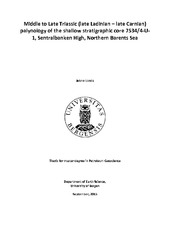| dc.description.abstract | In the Triassic period, a large seaway developed on the northern coast of Pangea, in the area which is the present-day Barents Sea. Deposition of sediment sourced from the Uralian Mountains in-filled this sea during the Late Triassic, forming a large prograding delta which gradually converted into a paralic platform. Very little palynological data are available from the northern Barents Sea due to the remoteness of the region. Several stratigraphic cores drilled by the Norwegian Petroleum Directorate in the area therefore provide important insights into the palaeogeography and depositional history of sediments in this part of the Barents Shelf. This study forms a part of a broader palynological investigation of the Middle to Late Triassic succession of the Barents Sea currently being undertaken at the University of Bergen. In the present study, palynological samples were collected from a shallow stratigraphic core, 7534/4-U-1, drilled in the Sentralbanken High in the Northern Barents Sea. The core penetrates approximately 230m of the De Geerdalen Formation (Snadd Formation equivalent), and the hypothesis, based on seismic, was that the Ladinian - Carnian transition should be recorded within this core. 56 samples were analyzed for palynostratigraphy and palynofacies. Investigation of this core reveals three distinct assemblages, assigned to range from late Ladinian to mid-late Carnian age. A palynomorph assemblage dominated by the monolete fern spore taxon Leschikisporis aduncus is the most prominent feature within this succession; similar assemblages have previously been documented from late Carnian deposits in the region. The palynofloral distribution and dominance of terrestrial kerogen is consistent with deposition close to fern dominated delta/coastal plain swamp. However, the sporadic presence of acritarchs and prasinophytes is indicative of episodic marine influence. | en_US |
